Nuri al-Rawi
Noori al-Rawi (1925-2014) was an Iraqi painter; a pioneer of Iraqi art who played an important role in shaping the Iraqi modern art movement through his roles as a practising artist, author, television presenter, art administrator and art critic.
Noori al-Rawi | |
|---|---|
نوري الراوي | |
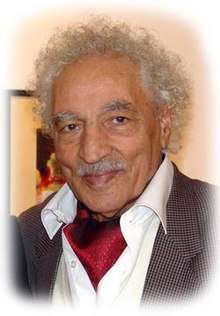 | |
| Born | Noori Al-Rawi 1925 Rawa, Ambar Province, Iraq |
| Died | 13 May 2014 (aged 89 years) Baghdad, Iraq |
| Nationality | Iraqi |
| Education | Baghdad University, Institute of Fine Arts, Baghdad (1959) |
| Known for | Painter, sculptor, art critic, art historian, art administrator and author |
Life and career
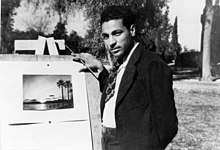
Noori al-Rawi was born in 1925 in Rawa, Al_Anbar, Iraq, in the fertile, agricultural lands between the Euphrates River and the mountains and near the Babylonian city of Anah.[1] This rural setting provided him with a lifelong source of inspiration, based on landscapes, villages and village life, all of which became his preferred subject matter.[2]
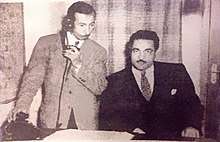
In his youth, he spent much of his time in the Baghdad Library, where he met the poet, Badr Shakir al-Sayyab, who lived in a government apartment nearby. The pair developed a friendship, and through this connection, al-Rawi learned about Iraq's ancient legacy in art and poetry.[3]
Al-Rawi began his working career teaching drawing and art, after having graduated from a local teachers' college. He later received a formal art education first at Baghdad University, and later at the Institute of Fine Arts, graduating in 1959. He subsequently received a scholarship to study print editing and television program production in Belgrade (1962).[4]
He was one of the pioneers of modern art in Iraq, producing a rich body of paintings and sculptures.[5] An active participant in Iraq's arts community, he was a founding member of the Baghdad Modern art group.[6] This group aimed to reassert a national identity through art and literature, by developing artworks with a distinctive Iraqi identity which referenced its ancient heritage and tradition.[7]
Although a prolific painter of some note, he is mostly remembered for his roles as an art historian, art critic and art administrator. He was one of the key founders of Baghdad's National Museum of Modern Art (1962) and served as its Director from 1962-1974, responsible for acquiring the artworks that would comprise the core collection. His focus for the collection was to acquire works along two parallel lines, the first was Iraqi art, and the second was Arabic paintings.[8] This was a challenging period for the museum in particular, and Iraqi art more generally, as the arts were seriously under-funded.[9] He was also instrumental in founding several other art museums including: the Pioneer Museum, the Faik Hassan Museum and the Iraqi Museum of Creativity.[10] He also established the first bronze smelter for use by local sculptors.[11]
He was a prolific writer and became a respected media presenter, using his position to promote the distinctive character of Iraqi art and cement Iraq's position at the forefront of contemporary pan-Arab art. From a very early stage in his career, he published articles in the magazines, Al-Rafidain and Al-Manahil.[12] The first to establish regular arts page in the Iraqi press, and supervised its editing. Established in 1952 and known as Time, News and Voice of the Free, the art page was instrumental in creating public interest in local art.[13] He was the editor of the New Iraq Magazine and Journal of the Gallery. [14] Later, he presented arts programs for Baghdad Television for some thirty years (1957-1987).[15]
He died in Baghdad on 13 May 2014 at the age of 89.[16]
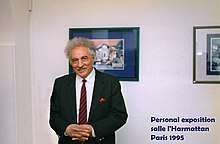
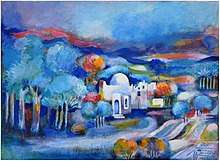
Work
His paintings often merge representation with abstraction. The traditional Iraqi town is a recurring theme in his paintings.[17] A large number of his paintings were stolen or destroyed during the 2003 looting of the Museum of Modern Art in Baghdad.[18]
He authored one of the first books on Iraqi art, Reflections on Modern Iraqi Art, as well as six other titles dealing with various aspects of art history and related themes:[19]
- Reflections on Modern Iraqi Art, 1962
- Introduction to Iraqi Folklore. 1962
- Jawad Saleem, 1963
- Modern German Art, 1965
- Iraq in Crafic, 1966
- Menem Firat Sculpture Fether, 1975
- Color in Science, Art and Life. 1986
Awards and honours
See also
References
- Hassan, O., "Nouri Al-Rawi: The Concepts of Contemporary Art Do not Fit into the Arab taste," Iraqi Art Critic, 30 May 2014, Online:
- Hussein, A., "Artist Nouri al-Rawi Passes Away," Iraqi News, 13 May 2014 Online:
- Hassan, O., "Nouri Al-Rawi: The Concepts of Contemporary Art Do not Fit into the Arab taste," Iraqi Art Critic, 30 May 2014, Iraqi Art Critic, Online:
- Hussein, A., "Artist Nouri al-Rawi Passes Away," Iraqi News, 13 May 2014 Online:
- Mehdi, S., "At the Exhibition of the Pioneers: Some Thoughts on the Work of Ismail Al-Sheikhly, Kadhim Haidar, Qahtan al-Madfai, Nuri Al-Rawi and Suzanne Al-Sheikhly," in: Modern Art Iraq Archive, Item #527, Online:
- Baram A., "Art With Local and Mesopotamian Components," in: Culture, History and Ideology in the Formation of Ba‘thist Iraq, 1968–89, [St Antony’s/Macmillan Series], London, Palgrave Macmillan, London, 1991, pp 279-80; Baram, A., Culture, History and Ideology in the Formation of Ba'thist Iraq, 1968-89, Springer, 1991, p. 69
- Ulrike al-Khamis, “An Historical Overview 1900s-1990s,” in: Maysaloun, F. (ed.), Strokes of Genius: Contemporary Iraqi Art, London:, Saqi Books, 2001, p. 25; Baram, A., Culture, History and Ideology in the Formation of Ba'thist Iraq, 1968-89, Springer, 1991, pp 70-71
- Hassan, O., "Nouri Al-Rawi: The Concepts of Contemporary Art Do not Fit into the Arab taste," Iraqi Art Critic, 30 May 2014, Online:
- Baram A., "Art With Local and Mesopotamian Components," in: Culture, History and Ideology in the Formation of Ba‘thist Iraq, 1968–89, [St Antony’s/Macmillan Series], London, Palgrave Macmillan, London, 1991, p. 280
- Al-Atabi, A.J., "The Departure of Nuri Al -Rawi: The latest Pioneer of Iraqi Art," [Obituary],Elaph, 14 May 2014, Online:
- Al-Amiri, A., "Nuri Al-Rawi: The Artist is a Spiritual Leader who Nourishes Beauty in the Souls of Human Beings," [Interview with Artist, published posthumously], Iraqi Art Critic, Online:
- Hassan, O., "Nouri Al-Rawi: The concepts of contemporary art do not fit into the Arab taste," Iraqi Art Critic, 30 May 2014, Iraqi Art Critic, Online:
- "Nouri al-Rawi," [Biographical Note], Barjeel Foundation, Online:
- "Behind the Shadow of his Mysterious Colors: the Departure of Nuri al-Rawi," [Obituary], Iraqi Art Critic, Online:
- Al-Atabi, A.J., "The Departure of Nuri Al -Rawi: The latest Pioneer of Iraqi Art," [Obituary],Elaph, 14 May 2014, Online:
- Hussein, A., "Artist Nouri al-Rawi Passes Away," Iraqi News, 13 May 2014 Online:
- "Nouri al-Rawi," [Biographical Note], Barjeel Foundation, Online:
- "The death of the latest Iraqi art pioneer Nuri Al-Rawi" [Obituary], Alhayat, Online: (translated from Arabic)
- Tejel, J., Writing the Modern History of Iraq: Historiographical and Political Challenges, World Scientific, 2012, p. 481
- Al-Atabi, A. J., "Behind the Shadow of his Mysterious Colors: the Departure of Nuri al-Rawi," [Obituary], Iraqi Art Critic, Online:
- Al-Atabi, A. J., "Behind the Shadow of his Mysterious Colors: the Departure of Nuri al-Rawi," [Obituary], Iraqi Art Critic, Online: